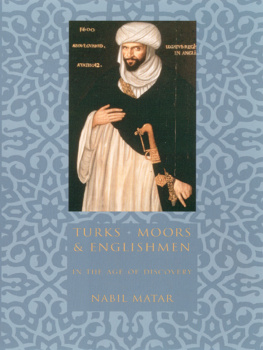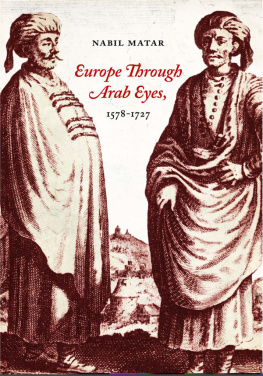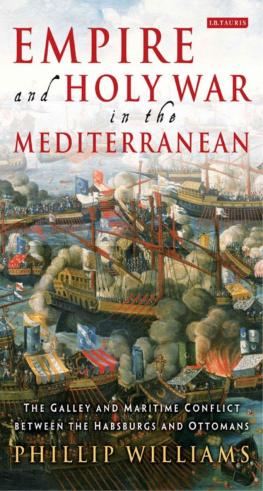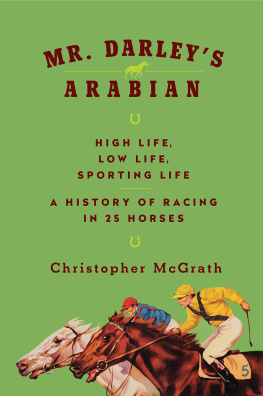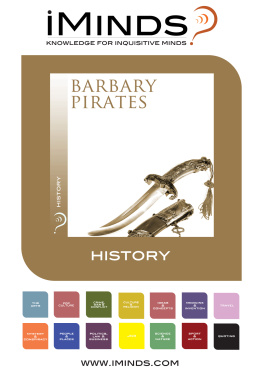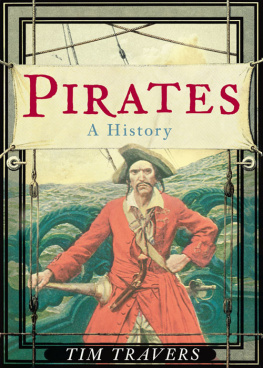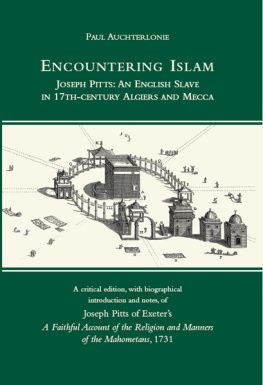Turks, Moors, and
Englishmen in the
Age of Discovery
Columbia University Press
Publishers Since 1893
New York Chichester, West Sussex
cup.columbia.edu
Copyright 1999 by Columbia University Press
All rights reserved
E-ISBN 978-0-231-52854-2
Library of Congress Cataloging-in-Publication Data
Matar, N. I. (Nabil I.)
Turks, Moors, and Englishmen in the age of discovery / Nabil I. Matar
p. cm.
Includes bibliographical references and index
ISBN 0-231-11014-6 (cloth)
ISBN 0-231-11015-4 (paper)
1. Middle EastRelationsGreat Britain. 2. Great BritainRelationsMiddle East. 3. Africa, NorthRelationsGreat Britain. 4. Great BritainRelationsAfrica, North. 5. Middle EastHistory15171882. 6. Africa, NorthHistory15171882. 7. Great BritainHistoryElizabeth, 15581603. 8. Great BritainHistoryStuarts, 16031714. 9. IndiansFirst contact with Europeans. I. Title.
DS63.2.G7M38 1999
303.48256041dc21 9844812
A Columbia University Press E-book.
CUP would be pleased to hear about your reading experience with this e-book at .
For Ibrahim and Hady
From the Elizabethan period and throughout the seventeenth century, Britons from England and Wales, and to a lesser extent, Scotland and Ireland, were exposed to the civilization of Islam. This civilization was experienced by means of its literature, culture, and languages, chiefly Arabic and Turkish. It was also experienced as a theology that English and Scottish clerics confrontedeither in polemical texts or in disputations. Such an Islam could be written about, debated, denounced, admired, and scrutinized without bringing the Briton into contact with a single Muslim man or woman. It could be praised for its sufi models, attacked for its Mahometan berry (coffee), threatened by eschatological destruction, or denounced for its renegadesall from the safety of Britains insular borders. It is a testimony to the vast impact of Islam on Renaissance England and the British Isles that despite the limitations of this exposure, the Arab-Islamic legacy permeated English discourse and thought. In Islam in Britain, 1558-1685, I attempted to examine that legacy and showed that although a centripetal relation governed Islam and Britain, by the end of the seventeenth century, that relation had become centrifugal and oppositional.
In this book, I shall show how that change was effected by focusing on the Age of Discovery, the period that corresponds in England to the time between the Elizabethan period and the beginning of the Great Migration in the Caroline period. Specifically, I shall examine this interaction in the light of Englands concurrent encounter with another non-Christian peoplethe American Indians. Students of the English Renaissance have ignored the importance of the fact that Britons encountered Muslims at the same time they encountered American Indians. Only three years after the Turkey Company had been established in 1581, Sir Walter Raleighs first project for settlement in Roanoke, Virginia, was launched (1584), and in 1585, two years before the second Roanoke project was undertaken, the Barbary Company was formed to strengthen Englands trade with Morocco, which had existed since the 1550s. The ventures to North America and to North Africa and the Levant occurred so close together in time that, throughout the period under study, the English were in a triangular geographical relationship. They lived and traded among the Turks and Moors while simultaneously or subsequently trading with the American Indians and living in their lands.
The encounters with the Muslims and the American Indians took place at different political, colonial, and military levels. But within the Elizabethan and Stuart discourse of Otherness and empire, the two encounters were superimposed on each other so that the sexual and military constructions of the Indians were applied to the Muslims. These constructions might well have remained a symptom of cultural stereotyping and ignorant representation had they not made possible the ideological discourse that accompanied the conquest of Islam in the eighteenth and nineteenth centuries. In the Renaissance conquest of America lay the groundwork for colonialism and orientalism.
I wish to thank many colleagues and friends who have read all or parts of this book, and who have been of great help to me. First and foremost is Dr. Jane Patrick, former Humanities Department head at Florida Tech, who always organized my schedule in a way that allowed me to travel to libraries and conferences. She also read, patiently and willingly, every typescript I gave her. For the past twelve years her advice, prudence, and encouragement have been invaluable to me. Now enjoying retirement with her family, she will always be remembered as a dear friend.
I also wish to thank Alex Baramki for patiently reading the galleys; Dina for helping me with translations; Daniel Vitkus of Florida Tech for his numerous insights; Mordechai Feingold of Virginia Tech for his encouraging reading; Raymond-Jean Frontain of the University of Central Arkansas for commenting on chapter 4; Salim Kemal of Dundee University for his perceptive emails; Mohammad Shaheen of Jordan University for many discussions at Oxford; and the tourist guide, John (he never bothered to tell me his surname), a Native American who walked me through the Chaco Canyon in 1995 and told me the other history of America.
I am grateful to Chris Larson of UCLA for inviting me to participate in the Seminar on Toleration in 1997, which taught me a lot. I am also grateful to the editors of Journal of Islamic Studies, Explorations in Renaissance Culture, and Literature Interpretation Theory for permission to use some of the material I had published in their journals: Muslims in Seventeenth-Century England, Journal of Islamic Studies, 8 (1997): 6382, copyright Oxford University Press; English Renaissance Soldiers in the Armies of Islam, Explorations in Renaissance Culture, 21 (1995): 8195, copyright South Central Renaissance Conference; and The Traveller as Captive: Renaissance England and the Allure of Islam, Literature Interpretation Theory, 7 (1996): 187196, copyright Gordon and Breach Publishers. Many thanks are also due respondents at the following conferences: The Image of the Other, at The American University in Cairo, 1996; the South Central Renaissance Conference, in Austin, Texas, 1997; and the Seventh International Conference, in Durham, England, 1997. I am particularly grateful to Donald Dickson of Texas A & M University for allowing me to test my thesis as a presentation before the Interdisciplinary Colloquium.
Any shortcomings that remain in this book are my own.
I wish to thank the staff and librarians at Houghton Library, Harvard University; the University Library, Cambridge University; the British Library, London; Durham University Library, Durham; the Public Record Office, London; the University of Florida Library; and the Baylor University Library. In particular, I wish to thank Ms. Victoria Smith at the Inter-Library Loan desk at Evans Library, Florida Tech, and Ms. Linda Khan at the microfilm center, for their continued assistance and kindness. Both always went out of their way to help.
Finally, I wish to thank Marilyn Goravitch, whose computer wizardry, intelligence, and sincere cooperation made this and other projects possible. I also want to thank Sue Downing and Peggy Machado for their moral support and help; my mother in the solitariness of her octogenarianism; and my children, Ibrahim and Hady, to whom this book is dedicated, with apologies that, while writing this book, I could not compete with Richies dad, who built a car all by himself.
The English Renaissance was the Age of Discovery and exploration, of the westward venture to America and beyond, that dramatically changed English and world history. But from the Elizabethan to the early Caroline periods, Britons undertook another venture as they entered into an extensive commercial, diplomatic, and social engagement with the Turks and Moors of the Muslim empires. No other non-Christian people interacted more widely with Britons than the Muslims of the Ottoman Empire, the Eastern Mediterranean, and the North African regencies of Tunisia, Algeria, and Libya, along with Morocco (which was not under Ottoman domination). These Muslims were real in a physical and linguistic sense, and represented the most widely visible non-Christian people on English soil in this periodmore so than the Jews and the American Indians, the chief Others in British Renaissance history.
Next page
